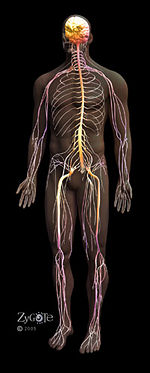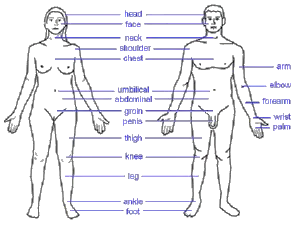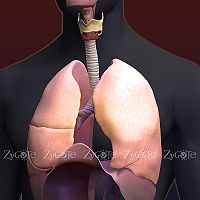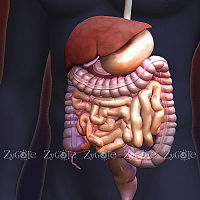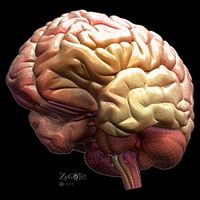Difference between revisions of "Human body" - New World Encyclopedia
Rick Swarts (talk | contribs) |
Rick Swarts (talk | contribs) |
||
| Line 29: | Line 29: | ||
==Tissues== | ==Tissues== | ||
| − | ** | + | Tissues are collections of similar cells that perform a specialized function. The human body has four primary tissue types: |
| + | |||
| + | * [[Muscle]] tissue. Muscle tissue makes up the muscles of the body. There are approximately 650 skeletal muscles in the human body. Muscle tissue has the ability to contract. There are three general types of muscle: smooth muscle (or "involuntary muscle"), such as foundin the [[intestine]] and [[throat]], cardiac muscle, an involuntary muscle found only in the heart; and skeletal muscle, a voluntary muscle anchored by tendons to bones and used for skeletal movement. Muscle tissue is composed of muscle cells. All three types of muscle use actin and myosin to produce contraction and relaxation, and thus movement. Exercize does not increase muscles, but rather the size of the muscle cells. | ||
| + | * [[Nerve]] tissue. | ||
| + | |||
| + | |||
| + | |||
Revision as of 13:46, 23 February 2006
As commonly defined, the human body is the physical matter of a human being, including the chemical elements, cells, and extracellular materials and the organization of these materials into tissues, organs, and systems. The human body, like the bodies of all animals, is made up of systems, that are made up of organs, that are made up of tissues, that are made up of cells.
Several fields are involved in the study of the human body. Human anatomy or anthropotomy is a specialized field within anatomy that is focused on the structure and form of the human body, such as the description of organs and organ systems Human physiology is a specialized field within physiology that encompasses the study of the functioning of the human body, including systems, tissues, and cells. Thus, physiology tends to be more dynamic, and concerned with functioning, while anatomy is more descriptive of structure. The study of tissues is the focus of histology and the study of cells is part of cytology.
Since human beings define themselves not just in biological terms, but also in social, spiritual, and religous terms, it is natural that the term "human body" can take on broader meanings than defined above. In some religions, for example, there is a concept that humans have not only a physical body, but also a "spiritual body," which may mirror the appearance of the physical body, but that also exists after the death of the physical body. An example of such is found in the Bible: "??? spiritual body".
In addition, the concept of human body is often used in context of "mind-body unity" or "mind-body" disunity, in order to convey a separation between physical and spiritual desires, or as reflected in philosophy, the "mind-body problem."
(look up the ICUS book on mind/brain, etc.)
Chemical elements
The most common chemical elements in the human body are oxygen (65% by mass), carbon (18%), hydrogen (10%), and nitrogen (3%), calcium (1.5%) and phosphorus (1.0%). These six elements make up 99% of the mass of the human body. Potassium (0.35%), sulfur (0.25%), sodium (0.15%) and magnesium ().05%) are the next four most common elements. Ten elements only combine for about 0.7% of the human body's mass: iron, , copper, zinc, selenium, molybedenum, fluorine, chlorine, iodine, manganese, and cobalt. Trace elements that have been identified include lithium, strontium, aluminum, silicon, lead, vanadium, arsenic, and bromine.
The most common compound in the human body is water, with cells having between 65% and 90% by weight. Four other common compounds are carbohydrates (such as glucose or starch), lipids (fats), nucleic acids, and proteins. These lst four all include the element carbon.
Cells
The average adult human body is estimated to have ten trillion cells. These range in size from a sperm cell, which is the smallest, to the egg cell, which is the largest. The sperm head is about 2.5 to 3.5 microns wide and 5 to 7 microns long, with a tail about 50 to 80 microns long. The egg cell is about 60 microns in diameter. In reality, muscle cells are larger because they are multinuclear and represent the fusion of many individual cells, and nerve cells are lage because of the axons, but the actual cell body is smaller than the egg.
There are a wide variety of types of cells, and they differ in size, shape and function. among the types of cells are bone cells, blood cells, nerve cells, muscle cells, stomach cells, etc. Red blood cells carry oxygen, bone sells form the skeleton of the body, nerve cells carry electrical signals, and muscle cells move the bones. Stomach cells secrete acids to digest food, and cells in the intestines absorb nutrients.
Tissues
Tissues are collections of similar cells that perform a specialized function. The human body has four primary tissue types:
- Muscle tissue. Muscle tissue makes up the muscles of the body. There are approximately 650 skeletal muscles in the human body. Muscle tissue has the ability to contract. There are three general types of muscle: smooth muscle (or "involuntary muscle"), such as foundin the intestine and throat, cardiac muscle, an involuntary muscle found only in the heart; and skeletal muscle, a voluntary muscle anchored by tendons to bones and used for skeletal movement. Muscle tissue is composed of muscle cells. All three types of muscle use actin and myosin to produce contraction and relaxation, and thus movement. Exercize does not increase muscles, but rather the size of the muscle cells.
- Nerve tissue.
Major systems of the human body
- Cardiovascular system: blood circulations with heart and blood vessels
- Digestive system: processing food with mouth, stomach and intestines
- Endocrine system: communicating within the body using hormones
- Excretory system: eliminating wastes from the body
- Immune system: defending against disease-causing agents
- Integumentary system: skin, hair and nails
- Muscular system: moving the body
- Nervous system: collecting, transferring and processing information with brain and nerves
- Reproductive system: the sex organs
- Respiratory system: the organs used for breathing, the lungs
- Skeletal system: structural support and protection through bones.
External features
Common names of well known parts of the human body, from top to bottom :
- Skin
- Head — Forehead — Eye — Ear — Nose — Mouth — Tongue — Teeth — Jaw — Face — Cheek — Chin
- Neck — Throat — Adam's apple — Shoulders
- Arm — Elbow — Wrist — Hand — Fingers — Thumb
- Spine — Chest — Breast — Ribcage
- Abdomen — Belly button — Sex organs (Penis/Scrotum or Clitoris/Vagina) — Rectum — Anus
- Hip — Buttocks — Leg — Thigh — Knee — Calf — Heel — Ankle — Foot — Toes
Internal organs
Common names of internal organs (in alphabetical order) :
- Adrenal glands — Appendix — Bladder — Brain — Duodenum — Gall bladder — Heart — Intestines — Kidney —Liver— Lungs — Ovaries — Pancreas — Parathyroid gland — Pituitary gland — Prostate gland — Spleen — Stomach — Thymus gland — Thyroid gland — Testicles — Womb
Anatomy of the brain
- Amygdala — Brainstem — Cerebellum — Cerebral cortex — Hypothalamus — Limbic system — medulla— midbrain — Pituitary gland — pons
- See also: Human brain, List of regions in the human brain
Studying human anatomy
Certain professions, especially medicine and physiotherapy, require the study of human anatomy in depth. Textbooks usually split the body into the following regional groups:
- Head and Neck - includes everything above the thoracic inlet
- Upper limb - includes everything from your hand, forearm, arm, shoulder, axilla, pectoral region and scapular region.
- Thorax - contains the region of the chest from the thoracic inlet to the thoracic diaphragm.
- Abdomen - everything from the thoracic diaphragm to the pelvic brim or to the pelvic inlet.
- The back - about the spine and its components, the intervetebral disks and bodies
- Pelvis and Perineum - the pelvis consists of everything from the pelvic inlet to the pelvic diaphragm. The perineum is everything below the pelvic diaphragm.
- Lower limb - the lower limb is usually everything below the inguinal ligament, including the thigh, the hip joint, the leg, and the foot.
ReferencesISBN links support NWE through referral fees
- H. A. Harper, V. W. Rodwell, P. A. Mayes, Review of Physiological Chemistry, 16th ed., Lange Medical Publications, Los Altos, California 1977.
Credits
New World Encyclopedia writers and editors rewrote and completed the Wikipedia article in accordance with New World Encyclopedia standards. This article abides by terms of the Creative Commons CC-by-sa 3.0 License (CC-by-sa), which may be used and disseminated with proper attribution. Credit is due under the terms of this license that can reference both the New World Encyclopedia contributors and the selfless volunteer contributors of the Wikimedia Foundation. To cite this article click here for a list of acceptable citing formats.The history of earlier contributions by wikipedians is accessible to researchers here:
The history of this article since it was imported to New World Encyclopedia:
Note: Some restrictions may apply to use of individual images which are separately licensed.
